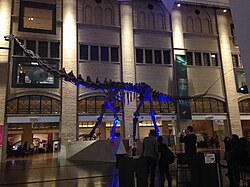| Lognkosaurians Temporal range: Early-Late Cretaceous, | |
|---|---|
 | |
| Replica mount of Futalognkosaurus at the Royal Ontario Museum | |
| Scientific classification | |
| Kingdom: | Animalia |
| Phylum: | Chordata |
| Class: | Reptilia |
| Clade: | Dinosauria |
| Clade: | Saurischia |
| Clade: | † Sauropodomorpha |
| Clade: | † Sauropoda |
| Clade: | † Macronaria |
| Clade: | † Titanosauria |
| Clade: | † Colossosauria |
| Clade: | † Lognkosauria Calvo et al. 2007 |
| Genera [1] [2] | |
| |
Lognkosauria is a clade of giant long-necked sauropod dinosaurs within the clade Titanosauria. It includes some of the largest and heaviest dinosaurs known. They lived in South America and Asia during the Late Cretaceous period.











